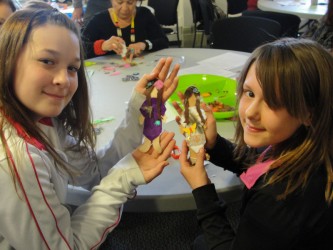Article Origin
Volume
Issue
Year
Hope and hopelessness is what Cree Elder Lillian Shirt says came through as relatives of missing and murdered Aboriginal women and girls made dolls in memory of their loved ones.
“The hope that their loved ones are somewhere out there, that they will be found alive,” said Shirt. “The hopelessness is that hoping they didn’t suffer.”
Families of missing and murdered Aboriginal women and girls came together earlier this month getting strength and support from each other as they shared their stories and decorated dolls.
“It’s a memory. Like making their journey clothes as we do in our traditional burials, making their journey clothes, they’re all sewn by hand,” said Shirt. A meal followed the doll-making workshop and Shirt likened that to the journey feast “for the ones who have gone ahead.”
“Family members … find the project is very healing,” said Jennifer Lord, strategic policy liaison with the Native Women’s Association of Canada. NWAC is the only national organization with a team working to raise awareness and do research on the issue of missing and murdered Aboriginal women.
Edmonton was the sixth stop for the NWAC faceless doll project which was designed to put action to words. The workshop is based on artist Gloria Larocque’s Aboriginal Angel Doll Project. Larocque, who is from Sturgeon Lake First Nation but lives in Vancouver now, was in attendance in Edmonton.
NWAC’s Evidence to Action team determined that people wanted a more hands-on approach to bringing attention to the issue. Collaborating with Larocque, NWAC created the simple six-inch flat felt dolls to be completed in a one hour workshop. Participants decorate the dolls as they wish. Some dolls are finished elaborately using beads and feathers, some in jingle dresses, while others are done simply.
“We want to add value, reclaim that image of an Aboriginal woman being strong and beautiful,” Lord said.
This hands-on project is one way NWAC is addressing the issue of missing and murdered Aboriginal women. The organization is also studying why so many of the 582 documented cases from the 1980s and on have occurred in the western provinces. However, Lord noted, the issue impacts straight across Canada.
Alberta accounts for 16 per cent of those missing or murdered Aboriginal women, second only to British Columbia which has 28 per cent of the recorded cases.
Lord is quick to caution that the figure of 582 is low, especially when considering the history First Nations, Métis and Inuit people have with the police. This figure acknowledges the missing or murdered women who are on police files, have been reported in the media or whose family member or community provided information to NWAC.
Lord believes there are a number of factors that come in to play to create the high concentration in the west: higher Aboriginal populations in the urban centres (Edmonton’s Aboriginal population is second only to Winnipeg) along with a high level of racism.
“There are many different issues of what we’re talking about, obviously the impact of colonization, residential schools, and the ‘60s Scoop, but the larger issue here of why this is happening … is the devaluing of Aboriginal women and girls in our society,” said Lord.
For Lord, who is a Métis from Lac Ste. Anne, determining the reasons why so many Aboriginal women have become victims to violence in her home province is especially important.
Lord is hoping to have 582 dolls created by the end of August in time for NWAC’s annual general meeting. Each workshop produces 50-60 dolls. When the dolls are all completed, Lord said it will become a travelling exhibit.
- 13757 views

